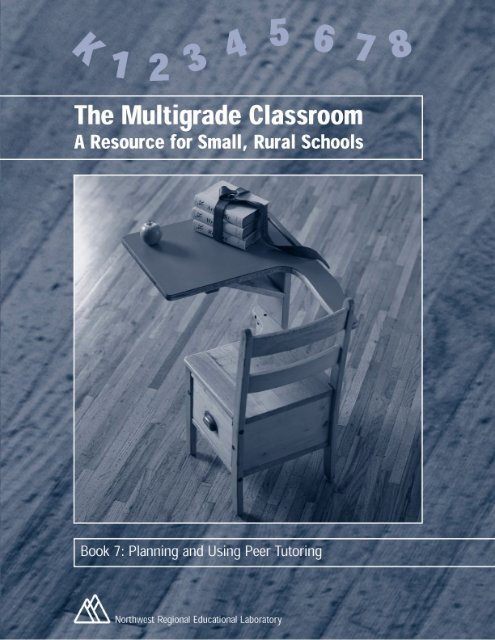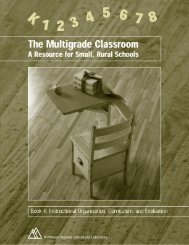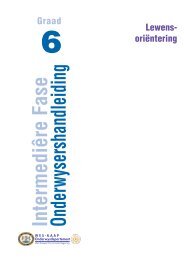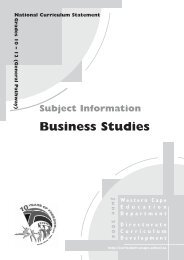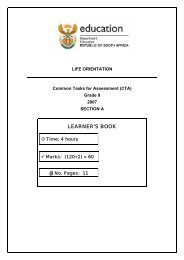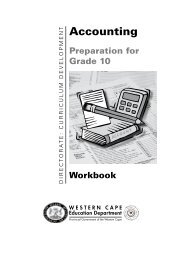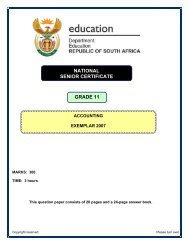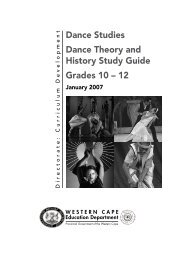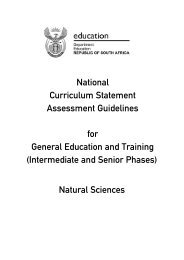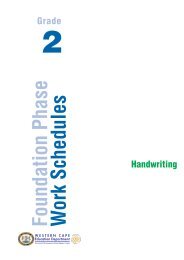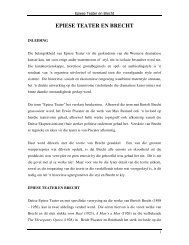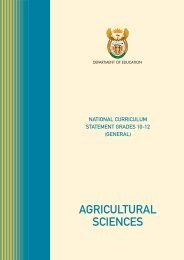Book 7: Planning and Using Peer Tutoring - Education Northwest
Book 7: Planning and Using Peer Tutoring - Education Northwest
Book 7: Planning and Using Peer Tutoring - Education Northwest
Create successful ePaper yourself
Turn your PDF publications into a flip-book with our unique Google optimized e-Paper software.
OverviewPrefaceThe preface describes the process used in developing this h<strong>and</strong>book,including the multigrade teachers who shared their classroom strategies<strong>and</strong> ideas for improving the usefulness of the h<strong>and</strong>book.IntroductionThe history of multigrade classroom instruction is presented, alongwith the background information that describes why multigradeinstruction is an important <strong>and</strong> complex issue for educators.<strong>Book</strong> 1: Review of the Research on Multigrade InstructionIn this book, the research on multigrade instruction is reviewedin order to answer two questions: (1) What effect does multigradeinstruction have on student performance? <strong>and</strong> (2) What kind of trainingis needed in order to teach in a multigrade classroom? Detailedinformation focusing on organizing <strong>and</strong> teaching in a multigrade classroomis also presented.<strong>Book</strong> 2: Classroom OrganizationThis book describes strategies for arranging <strong>and</strong> organizing instructionalresources <strong>and</strong> the physical environment of the classroom. Sampleclassroom layouts <strong>and</strong> a “design kit” for organizing your classroom arealso included.<strong>Book</strong> 3: Classroom Management <strong>and</strong> DisciplineEstablishing clear expectations for student behavior <strong>and</strong> predictableclassroom routines has been shown to improve student performance.In this book, research relating to classroom management <strong>and</strong> disciplineare presented, along with a checklist for planning management routines<strong>and</strong> discipline procedures.<strong>Book</strong> 4: Instructional Organization, Curriculum, <strong>and</strong> EvaluationResearch-based guidelines for planning, developing, <strong>and</strong> implementinginstructional strategies are presented. This book emphasizes the developmentof cooperative work norms in the multigrade classroom <strong>and</strong>explains how to match instruction to the needs of students. An overviewof curriculum <strong>and</strong> evaluation planning concepts is also provided. Thisbook is a close companion piece with book 5: Instructional Delivery<strong>and</strong> Grouping.ivThe Multigrade Classroom
<strong>Book</strong> 5: Instructional Delivery <strong>and</strong> GroupingThis book emphasizes that instructional quality <strong>and</strong> student groupingare key components for success in the multigrade classroom.Instructional methods such as recitation, discussion, <strong>and</strong> cooperativelearning are reviewed. <strong>Planning</strong> guides <strong>and</strong> examples are also includedwhere appropriate. Strategies for organizing group learning activitiesacross <strong>and</strong> within grade levels, especially those that develop interdependence<strong>and</strong> cooperation among students, are discussed.<strong>Book</strong> 6: Self-Directed LearningDeveloping skills <strong>and</strong> strategies in students that allow for a high levelof independence <strong>and</strong> efficiency in learning, either individually or incombination with other students, is essential in the multigrade classroom.Ideas for developing self-direction are presented in this book.<strong>Book</strong> 7: <strong>Planning</strong> <strong>and</strong> <strong>Using</strong> <strong>Peer</strong> <strong>Tutoring</strong>This book provides guidelines for developing skills <strong>and</strong> routines wherebystudents serve as “teachers” to other students within <strong>and</strong> across differinggrade levels. The research on what makes for effective tutoring inthe classroom is also reviewed.v
<strong>Book</strong> 1: Review of the Research on Multigrade Instruction<strong>Book</strong> 2: Classroom Organization<strong>Book</strong> 3: Classroom Management <strong>and</strong> Discipline<strong>Book</strong> 4: Instructional Organization, Curriculum, <strong>and</strong> Evaluation<strong>Book</strong> 5: Instructional Delivery <strong>and</strong> Grouping<strong>Book</strong> 6: Self-Directed Learning<strong>Book</strong> 7: <strong>Planning</strong> <strong>and</strong> <strong>Using</strong> <strong>Peer</strong> <strong>Tutoring</strong>Purpose <strong>and</strong> Scope of the H<strong>and</strong>bookThe h<strong>and</strong>book has been written to serve three general purposes:lllTo provide an overview of current research on multigradeinstructionTo identify key issues teachers face when teaching in a multigradesettingTo provide a set of resource guides to assist novice <strong>and</strong>experienced multigrade teachers in improving the qualityof instructionHowever, because of the complexity of multigrade instruction <strong>and</strong> thevast amount of research on effective classroom instruction, this h<strong>and</strong>bookcan only serve as a starting point for those educators wanting to learn newskills or refine those they already possess.Each book of the series presents information, strategies, <strong>and</strong> resourcesconsidered important for the multigrade teacher. While all the books arerelated, they also can st<strong>and</strong> alone as separate documents. For example, thebooks on Classroom Organization (<strong>Book</strong> 2) <strong>and</strong> Classroom Management<strong>and</strong> Discipline (<strong>Book</strong> 3) contain overlapping information. Ideally, thesetwo books are best utilized together. The same is true of the books onInstructional Organization, Curriculum, <strong>and</strong> Evaluation (<strong>Book</strong> 4) <strong>and</strong>Instructional Delivery <strong>and</strong> Grouping (<strong>Book</strong> 5). Wherever possible, theserelationships have been noted in the appropriate books.In conclusion, the series of books has been designed to be used asa research-based resource guide for the multigrade teacher. It covers themost important issues the multigrade teacher must address to be effectivein meeting the needs of students. Sample schedules, classroom layouts,resource lists, <strong>and</strong> strategies aimed at improving instruction have been usedthroughout. It is our hope that the h<strong>and</strong>book will raise questions, provideanswers, <strong>and</strong> direct the multigrade teacher to resources where answers toother questions can be found.vii
Participants in the Multigrade ConferenceKalistus NgirturongAimeliik ElementaryBabeldaob Isl<strong>and</strong>Republic of PalauRobin LovecSpringdale SchoolSpringdale, MontanaAnthony MoorowYap Department of <strong>Education</strong>Colonia, YapCheryl MikolajcvykKaumakakai, HawaiiLeslie GordonPitkas Point SchoolSt. Mary’s, AlaskaJames MakphieMajuro, Marshall Isl<strong>and</strong>sEdith NicholasAndrew K. Demoski SchoolNulato, AlaskaBenjamin BernardMajuro, Marshall Isl<strong>and</strong>sLinda PelroyW.W. Jones ElementaryArock, OregonJohn RusyniakMentasta Lake SchoolMentasta Lake, AlaskaPatricia ReckBrothers SchoolBrothers, OregonBill RadtkeEnglish Bay SchoolEnglish Bay, AlaskaPhil M. GilliesStone ElementaryMalad, IdahoCarol SpackmanPark Valley SchoolPark Valley, UtahBarbara RobinsonArbon Elementary SchoolArbon, IdahoMonte Phoenix <strong>and</strong> KarriePhoenixOrovada, NevadaJoel AndersonOnion Creek ElementaryColville, WashingtonMarty KarlinTrinity Center SchoolTrinity Center, CaliforniaTroy SmithDixie Elementary SchoolDixie, WashingtonJill BillsS<strong>and</strong>ers Elementary SchoolS<strong>and</strong>ers, ArizonaDarci ShaneSouthview SchoolVida, MontanaEileene ArmstrongMelrose ElementaryMelrose, MontanaPam CunninghamS<strong>and</strong> Springs ElementaryS<strong>and</strong> Springs, MontanaJennifer McAllisterDeerfield ElementaryLewistown, MontanaKimberly RindalAyers ElementaryGrass Range, MontanaSammy VickersGrant ElementaryDillon, MontanaBrian WolterAvon ElementaryAvon, MontanaviiiThe Multigrade Classroom
for older children out of their roles as teachers <strong>and</strong> nurturers, <strong>and</strong> foryounger children out of their opportunity to observe <strong>and</strong> model the behaviorof their older classmates (Katz et al., 1990; Ridgway & Lawton, 1969).The multigrade classroom has traditionally been an important <strong>and</strong>necessary organizational pattern of education in the United States, notesMiller (1993). Multigrade education dates back to the one-room schoolsthat were the norm in this country until they were phased out in the earlypart of the 1900s (Cohen, 1989; Miller, 1993). From the mid-1960sthrough mid-1970s, a number of schools implemented open education,ungraded classrooms, <strong>and</strong> multigrade groupings. Although some schoolscontinued to refine <strong>and</strong> develop the multigrade concept, many of theseprograms disappeared from public schools. With the beginning of theindustrial revolution <strong>and</strong> large-scale urban growth, the ideal of mass publiceducation took root <strong>and</strong> the practice of graded schools began in earnest.The graded school system provided a means of organizing <strong>and</strong> classifyingthe increased number of urban students of the 1900s. Educators foundit easier to manage students by organizing them into age divisions or grades.Other factors, such as the advent of the graded textbook, state-supportededucation, <strong>and</strong> the dem<strong>and</strong> for trained teachers, further solidified gradedschool organization (Miller, 1993; Uphoff & Evans, 1993). Critics of thegraded school were quick to emphasize this deficiency. The realization thatchildren’s uneven developmental patterns <strong>and</strong> differing rates of progress areill-matched to the rigid grade-level system has resulted in a growing interestin <strong>and</strong> study of the potential benefits of multigrade education in recent years(Miller, 1996). This growing interest is due to a greater focus on the importanceof the early years in efforts to restructure the educational system(Anderson, 1993; Cohen, 1989; Stone, S.J., 1995; Willis, 1991) <strong>and</strong>an awareness of the limitations of graded education.The multigrade classroom is labor intensive <strong>and</strong> requires more planning,collaboration, <strong>and</strong> professional development than the conventional gradedclassroom (Cushman, 1993; Gaustad, 1992b; Miller, 1996). Sufficientplanning time must be available to meet the needs of both teacher <strong>and</strong>students. Insufficient planning, staff development, materials, support, <strong>and</strong>assessment procedures will have an impact on the success of the multigradeprogram (Fox, 1997; Miller, 1996; Nye, 1993).Despite these constraints, there are special advantages to multigradeclassrooms. Flexible schedules can be implemented <strong>and</strong> unique programsdeveloped to meet students’ individual <strong>and</strong> group interests <strong>and</strong> needs.Combined classrooms also offer ample opportunity for students to becomeresourceful <strong>and</strong> independent learners. The multigrade rural classroom isusually less formal than the single-grade urban or suburban classroom.Because of the small class size, friendly relationships based on underst<strong>and</strong>ing<strong>and</strong> respect develop naturally between the students <strong>and</strong> the teacher. InxThe Multigrade Classroom
this setting, students become well-known by their teacher <strong>and</strong> a familyatmosphere often develops.However, many teachers, administrators, <strong>and</strong> parents continue towonder whether multigrade organization has negative effects on studentperformance. For most rural educators, multigrade instruction is not anexperiment or a new educational trend, but a forceful reality based oneconomic <strong>and</strong> geographic necessity. In a society where educational environmentsare dominated by graded organization, the decision to combine gradesis often quite difficult. The Rural <strong>Education</strong> Program of the <strong>Northwest</strong>Regional <strong>Education</strong>al Laboratory receives numerous requests from ruraleducators with two overriding concerns regarding multigrade classrooms:llWhat effect does multigrade instruction have on studentperformance?What kind of preparation or training is needed to be an effectiveteacher in a multigrade classroom?This h<strong>and</strong>book will provide answers to these questions <strong>and</strong> developan overview of key issues facing school districts <strong>and</strong> teachers involved inor contemplating multigrade classrooms.xi
ContentsWhat Is <strong>Peer</strong> <strong>Tutoring</strong>?..............................................................................1Incidental <strong>Peer</strong> <strong>Tutoring</strong> ....................................................................1Structured <strong>Tutoring</strong> ..........................................................................3What <strong>Tutoring</strong> Conditions Produce the Greatest Success? ..........................4What Makes <strong>Peer</strong> <strong>and</strong> Cross-Age <strong>Tutoring</strong> Effective?..................................5How Do Student Tutors Benefit From <strong>Tutoring</strong> ............................................6What Problems Are Commonly Encountered?..............................................7What Elements Are Necessary for a Successful Program? ..........................8Developing a <strong>Peer</strong> <strong>Tutoring</strong> Program in Your Classroom ..............................9Setting Goals <strong>and</strong> Choosing Learning Objectives..............................9Deciding Who Will Be Involved in <strong>Tutoring</strong> ..................................10Deciding Where <strong>Tutoring</strong> Will Take Place ......................................12Scheduling the <strong>Tutoring</strong> Sessions ....................................................12Deciding What Subjects Will Be Tutored ........................................13Deciding on <strong>Tutoring</strong> Materials, Procedures, <strong>and</strong> Strategies ............14Materials ..................................................................................14Tutor training (Keep it brief) ....................................................14<strong>Tutoring</strong> approaches <strong>and</strong> strategies............................................15Monitoring/feedback ................................................................15Evaluation ......................................................................................17Conclusion ............................................................................................18References ............................................................................................19Resources ..............................................................................................22<strong>Book</strong> 7: <strong>Planning</strong> <strong>and</strong> <strong>Using</strong> <strong>Peer</strong> <strong>Tutoring</strong>xiii
What Is <strong>Peer</strong> <strong>Tutoring</strong>?Outside of school, children learn from one another as a natural occurrencein daily life. A child having difficulty baiting a fishhook, buildinga birdhouse, baking a cake, or underst<strong>and</strong>ing model airplane directionswill often rely on a brother, sister, or friend for instruction, which usuallyinvolves both demonstration <strong>and</strong> explanation. In such situations, peertutoring is taking place.<strong>Peer</strong> tutoring is cooperation between two or more students, whereone individual imparts knowledge to the other(s). This can occur betweenstudents of the same age or grade (same-age tutoring) or between studentsof different ages or grades (cross-age tutoring). For example, when onestudent helps another student to learn math facts, we can say peer tutoringhas taken place. This may be a sixth-grade student helping a first-grader ortwo first-graders tutoring each other.In the traditional single-grade classroom, peer tutoring may occur onan incidental basis as when one student seeks help with a math problem fromhis or her neighbor. In the multigrade classroom, this incidental tutoring isan encouraged <strong>and</strong> necessary instructional activity. Research evidence specificallyfocusing on incidental tutoring in multigrade classrooms is nonexistent.However, research on structured tutoring programs is abundant <strong>and</strong> overwhelminglypositive. Therefore, greater emphasis will be placed on structuredtutoring. In addition, information collected from interviews <strong>and</strong> discussionswith multigrade teachers supports the belief that underlying successfulincidental tutoring are principles of effective instructional practice. Thisbook of the multigrade series will describe both incidental <strong>and</strong> structuredapproaches to tutoring, paying special attention to those characteristicsdeemed successful by teachers <strong>and</strong> researchers.In the multigrade classroom, peer tutoring provides the teacher with apowerful strategy for extending the teacher’s instructional influence. Whenteaching two or more different grades in a single classroom, especiallywhen class size pushes above 15 students, the teacher may have difficultydirectly responding to individual student needs. Multigrade teachers reportingon their experiences with peer tutoring indicated a strong dependenceon students helping one another (Ashl<strong>and</strong> Multigrade Conference in 1989).In nearly all reports, teachers indicated peer tutoring occurred on an incidentalbasis. That is, tutoring was not generally a systematically planned activity.As Carol Spackman, who teaches grades 4–8 in rural Utah, points out,“<strong>Peer</strong> tutoring at [my school] is usually spontaneous.” Spackman describesseveral examples:Incidental <strong>Peer</strong> <strong>Tutoring</strong><strong>Book</strong> 7: <strong>Planning</strong> <strong>and</strong> <strong>Using</strong> <strong>Peer</strong> <strong>Tutoring</strong>1
lll[Jerry] is a very low achiever. His interest span is very low<strong>and</strong> he completes very little work without help from someone.[Sarah] finishes her work quickly so I ask her to let [Jerry]read to her for 10 minutes a day.[I also have students] work out problems together. (How dowe do this math problem?)Have two students sit side by side with a newspaper <strong>and</strong> circleprepositions. The first [student] will circle three <strong>and</strong> then havethe other [student] circle three. Each student watches closelyto make sure the learner is correct.The four teachers at the Ashl<strong>and</strong> Multigrade Conference in Oregonwho participated in the peer tutoring workgroup developed a set of caseexamples of how they used peer tutoring in their classrooms. A fictitiousstudent named Joe is followed through a day in his multigrade school:English is Joe’s first subject of the day. The class has been assigned to learn the definition ofa noun <strong>and</strong> write 10 examples. Joe confuses nouns <strong>and</strong> verbs, so Amy has been assigned togo outside with Joe <strong>and</strong> gather 10 things that are nouns. She is to demonstrate, for example,why he cannot pick up a “jump” or a “run,” but that rocks <strong>and</strong> sticks are objects, <strong>and</strong>therefore, nouns.Next is math. Joe is struggling with simple addition. He <strong>and</strong> Bob are going to a quiet cornerwith a container of bottle caps. <strong>Using</strong> these concrete objects, Bob will demonstrate simpleaddition to Joe, then assist Joe in working his own problems.The next opportunity for peer tutoring for Joe is P.E., but with the roles reversed. A youngstudent is having difficulty doing proper pushups, an exercise Joe is very good at. Joe is askedto demonstrate a proper pushup, then offer tips in helping the younger student. Joe’s selfesteemis really boosted by being the “teacher,” <strong>and</strong> he takes his task very seriously.During spelling the class is divided into pairs for an individualized spelling program. Joequizzes his partner on his word list. The words are checked for spelling errors, then the rolesare reversed.These multigrade teachers indicated that peer tutoring need “not beplanned in the sense of being written in the plan book, but is part of a goodteacher’s mental arsenal of methods to help students.” It is worth notingthat these teachers each had several years of experience in the multigradeclassroom. As successful multigrade teachers, they learned through experienceto capitalize on the capabilities of their students to help one another.Seven different uses of peer tutoring in their classrooms were identified:2 The Multigrade Classroom
1. Drill each other—spelling, math, <strong>and</strong> so forth.2. Help other students develop a skill that the tutor possesses3. Build self-esteem of the tutor4. <strong>Peer</strong> modeling of skills—pushups, songs, dancing, <strong>and</strong> so forth.5. Ask a student to explain a concept in “kid language”6. Let a student (or students) teach a chapter in social studies7. Help each other with study skills <strong>and</strong> researchingIn addition, the teachers identified a set of instructions that would behelpful for the tutor to follow:llllllSmile.Be friendly.Speak clearly.Keep your voice to a whisper or whatever volumeis appropriate.Answer in a positive way. If the child makes a mistake, don’tsay things like, “wrong” or “no, that isn’t right” or “dummy.”Instead say, “That’s almost correct. Now listen while I repeatthe word, <strong>and</strong> then you repeat it after me.”Acknowledge correct work with a “that’s right,” “good job,”or some other positive statement or positive gesture.Although the incidental tutoring described by the multigrade conferenceparticipants was described as “spontaneous” <strong>and</strong> “not something placedin the teacher’s lesson plan book,” it still has an element of structure.But the structure is based on years of classroom experience, where the teacheroperates from a “good teacher’s mental arsenal of methods to help students.”In other words, these teachers are able to match the needs of differentstudents <strong>and</strong> apply an appropriate tutoring strategy in a spontaneous manner.However, when novice teachers enter the multigrade classroom, they generallydo not have the advantage of years of experience. For these teachers,research-based guidelines for tutoring may prove to be valuable.Structured <strong>Tutoring</strong><strong>Book</strong> 7: <strong>Planning</strong> <strong>and</strong> <strong>Using</strong> <strong>Peer</strong> <strong>Tutoring</strong>3
What <strong>Tutoring</strong> Conditions Producethe Greatest Success?Several features of peer tutoring have the greatest effect on studentachievement <strong>and</strong> attitude.1. Structured tutoring is more effective than tutoring on an incidentalbasis.2. <strong>Tutoring</strong> of shorter (zero to four weeks) duration appears to producethe best results. When tutoring continues past four weeks, there is adiminishing return.3. <strong>Tutoring</strong> where lower level skills are taught <strong>and</strong> tested produces thebest student outcomes.4. Greater results occur in math, followed by reading, than in othersubject areas.In using these results, remember that these conditions should not beviewed too narrowly or as absolutely necessary for successful peer tutoring.A large body of research on tutoring suggests that any organized <strong>and</strong> focusedtutoring program will likely have a positive impact on student learning (seeresearch reviews by Bartz & Miller, 1991; Cohen, Kulik, & Kulik, 1982;Gaustad, 1993). The type of tutoring program used should always be closelymonitored to determine if desired changes in the learner are occurring <strong>and</strong>,if not, the likely causes. Because rural multigrade classrooms are often moreinformal than single-grade classrooms, tutoring activities may be implementedin a less structured, more spontaneous way.4The Multigrade Classroom
What Makes <strong>Peer</strong> <strong>and</strong> Cross-Age<strong>Tutoring</strong> Effective?Children have certain advantages over adults in teaching peers. They maymore easily underst<strong>and</strong> tutees’ problems because they are cognitivelycloser. Allen <strong>and</strong> Feldman found that third- <strong>and</strong> sixth-graders weremore accurate than experienced teachers in determining from nonverbalbehavior whether agemates understood lessons (cited in Cazden, 1986;Gartner & Riessman, 1993; Hedin, 1987). The fact that their “cognitiveframework” is similar may also help peer tutors present subject matter interms their tutees underst<strong>and</strong>.<strong>Peer</strong> tutors can effectively model study skills such as concentrating onthe material, organizing work habits, <strong>and</strong> asking questions. Cohen notesthat similarity between model <strong>and</strong> learner increases the influence of modeling.An at-risk child may more easily identify with a student relatively closein age, particularly one of the same ethnic or social background, than withan adult. Higher status also promotes the effect of modeling. Cross-agetutoring takes advantage of the higher status inherent in the age differencewhile still retaining considerable similarity.Tutors who have struggled academically may be more patient <strong>and</strong> underst<strong>and</strong>ingthan those who haven’t. Empathy contributes greatly to low achievers’effectiveness as cross-age tutors. Tutors often “pick up on things teachersweren’t able to” because they experienced similar problems a few yearsearlier (Giesecke, Cartledge, & Gardner, 1993).<strong>Book</strong> 7: <strong>Planning</strong> <strong>and</strong> <strong>Using</strong> <strong>Peer</strong> <strong>Tutoring</strong>5
How Do Student Tutors BenefitFrom <strong>Tutoring</strong>?1. Tutors benefit academically from the time spent reviewing <strong>and</strong> practicingmaterial with their tutees. Tutors may also experience highercognitive gains. Organizing material to teach “facilitates long-termretention, as well as aiding in the formation of a more comprehensive<strong>and</strong> integrated underst<strong>and</strong>ing” (Cohen, 1986). <strong>Tutoring</strong> also providesopportunities to practice <strong>and</strong> improve communication skills <strong>and</strong>work habits.2. Tutors’ self-esteem rises as they see their tutees improve. Knowingthey are making a meaningful contribution is a powerful experience.Many tutors stop skipping classes <strong>and</strong> behaving disruptively afterthey realize they are role models for their tutees (Gaustad, 1992a).6The Multigrade Classroom
What Problems Are CommonlyEncountered?Simply putting two students together won’t result in successful tutoring.Untrained tutors, whether adults or students, may resort to threats ofpunishment <strong>and</strong> scornful put-downs. Tutors need training to mastereffective tutorial <strong>and</strong> communication skills.Another potential problem is that student tutors may not completelyunderst<strong>and</strong> the material to be taught. Cohen suggests assessing potentialtutors’ comprehension before assigning them to tutor. However, a tutor neednot be an excellent student, especially in the case of cross-age tutoring. “Asixth-grader operating at a fourth-grade level can be an excellent helper of asecond-grader who is also operating below grade level,” Foot, Shute, Morgan,<strong>and</strong> Barron (1990) point out.1. One drawback of peer tutoring is that tutees, often labeled as lesscapable than tutors, tend to resist being tutored by agemates.2. Scheduling is a challenge with cross-age tutoring because it requirescoordinating the schedules of two sets of students. Offering tutoringas a credit class gives tutors a predictable block of time. However,one period may not provide enough time if tutors <strong>and</strong> tutees attendschools some distance apart. Cardenas, Harris, del Refugio Robledo,<strong>and</strong> Supik (1991) found that many schools were unwilling to copewith the logistical problems of cross-age tutoring, despite its effectiveness.He designed the self-contained Companion ReadingProgram in response to this problem.<strong>Book</strong> 7: <strong>Planning</strong> <strong>and</strong> <strong>Using</strong> <strong>Peer</strong> <strong>Tutoring</strong>7
What Elements Are Necessaryfor a Successful Program?The design of a tutoring program is dictated by its objectives, includingthe targeted age group <strong>and</strong> subject area, <strong>and</strong> by the availability ofhuman, physical, <strong>and</strong> financial resources.Establishing specific, measurable objectives permits assessment ofindividual progress <strong>and</strong> evaluation of the program’s success as a whole.Frequent assessment of student progress gives program staff feedback onthe effectiveness of lessons <strong>and</strong> encourages both tutor <strong>and</strong> tutee (Jenkins& Jenkins, 1987).Procedures must be established for selecting <strong>and</strong> matching tutors <strong>and</strong>tutees. Examples of tutee selection criteria include test scores <strong>and</strong> teacherjudgment. Tutors may be screened for desired attitudes or levels of academiccompetence. The Valued Youth Program, which recruits students who meetstate at-risk criteria, accepts those with records of minor disciplinary problemsbut draws the line at criminal behavior.Tutors also may be given basic training to accompany carefully structuredmaterials, as in the Companion Reading Program, or extensive trainingthat enables them to make more independent decisions. Extensivetraining is desirable when tutor progress is the main objective.Tutors need ongoing supervision <strong>and</strong> support. Younger tutors willrequire more structure <strong>and</strong> closer supervision. In periodic group meetings,older tutors gain psychological support by talking about frustrations <strong>and</strong>sharing success stories. Tutors can learn from each other’s experiences aswell as from staff suggestions for h<strong>and</strong>ling problems.Support by teachers <strong>and</strong> administrators is essential for a tutoringprogram to succeed in the long run. Foot, et al., (1990) list typical problems<strong>and</strong> concerns <strong>and</strong> recommend openly discussing them beforeh<strong>and</strong>. Parents<strong>and</strong> the community should also be informed. Teachers who underst<strong>and</strong> <strong>and</strong>believe in a program’s potential to help their children will generally be firmsupporters.Decades of research have established that well-planned peer tutoringprograms can improve student achievement <strong>and</strong> self-esteem as well as overallschool climate. The wide variety of programs available should enable everyinterested school district to find a format that suits its needs.8The Multigrade Classroom
Developing a <strong>Peer</strong> <strong>Tutoring</strong> Programin Your ClassroomBefore a tutoring program is implemented, six important question areasneed to be reviewed <strong>and</strong> answered. Without some idea of where youwant to go <strong>and</strong> how you plan to get there, your chances of ever arrivingare slim. The following questions will serve as a planning guide. You willalso find a checklist consisting of questions <strong>and</strong> statements that will behelpful in thinking about what you should do. The checklist is divided intosections that focus on selecting students, deciding where tutoring will takeplace, scheduling, choosing materials <strong>and</strong> strategies, <strong>and</strong> evaluation.Setting Goals <strong>and</strong> Choosing Learning ObjectivesIt is important that you specify the goals of your tutoring effort. What doyou want to happen as a result of tutoring? Do you want to improvestudent performance in math or reading? Do you want to develop studentself-direction <strong>and</strong> responsibility? Do you want to improve tutor self-esteem?Do you simply want to better manage the many different age levels of yourmultigrade classroom? Successful peer tutoring may have positive effectson many different areas at the same time, but the important thing is to beclear on your primary purpose for using tutoring. Begin planning yourtutoring program by writing down a few goals you would like to achieve.To help you write your own tutoring goals, several examples follow:lll<strong>Peer</strong> tutoring will be used in my classroom to increase achievement<strong>and</strong> on-task time in math for first- <strong>and</strong> second-graders<strong>Peer</strong> tutoring will be used during oral reading to increasestudent fluency <strong>and</strong> motivation<strong>Peer</strong> tutoring will be used to help students perform betteron spelling quizzesNotice that each goal consists of two common elements: (1) who willreceive the tutoring (first-<strong>and</strong> second-graders, all reading students, thoseperforming poorly), <strong>and</strong> (2) what the tutoring will focus on (math achievement,on-task time, reading fluency, motivation, <strong>and</strong> poor spelling performance).In deciding your goals, be sure to include these two elements.Equally important is establishing specific objectives (learner outcomes)for each tutoring pair or group that can be easily assessed. The followingexample illustrates how to establish a goal <strong>and</strong> an objective for tutoring:<strong>Book</strong> 7: <strong>Planning</strong> <strong>and</strong> <strong>Using</strong> <strong>Peer</strong> <strong>Tutoring</strong>9
Mrs. M decided to start a tutoring program to help Michael because he was performingpoorly in division. Michael understood how to complete the problems, but his accuracy wasworse <strong>and</strong> speed was much slower than other students. Mrs. M determined that Michaeldid not know basic multiplication facts. He continually used his fingers. Mrs. M decided touse Bill as a tutor. He got along well with other students <strong>and</strong> could be counted on to followthrough on activities or tasks he started. Mrs. M described what Michael needed to learn.Michael’s learningobjectiveMichael will learn his times tables through the 4’s so that he can finish amixed-facts worksheet in two minutes without missing more than fiveproblems.Mrs. M wrote the learning objective so that it could be easily understoodby Bill <strong>and</strong> Michael. Note that the objective has several important elements:1. It is based on the student’s classroom learning needs.2. It is clear <strong>and</strong> easy for both the tutor <strong>and</strong> learner to underst<strong>and</strong>.3. It is easy to measure.Remember, in developing plans, be sure you know why you wantto use peer tutoring (tutoring goals) <strong>and</strong> what specific objective (learneroutcome) tutoring pairs or groups will work on.Deciding Who Will Be Involved in <strong>Tutoring</strong>The selection <strong>and</strong> matching of tutor <strong>and</strong> learner is an important task.Topping (1988) identifies 10 crucial areas when considering whoshould participate in tutoring. These areas will help guide you inmaking decisions regarding student participation. Each area is designedto be used for both the tutor <strong>and</strong> the learner.1. How will students be selected?llWill you ask students or other teachers?Will you observe the students?2. What level of students will be tutored?llWill you select same-grade/-age tutors, cross-age tutors,or both?What are the advantages <strong>and</strong> disadvantages of either approach?10The Multigrade Classroom
3. What kind of academic skills will the tutor have?lllWill you select tutors with higher-than-average scholastic ability?Will you select students with below-average ability in orderto help them develop their skills?Will you select students with the same scholastic ability?4. Have you thought about student relationships?llHow will you deal with existing positive or negative relationshipsamong students?How will you deal with weak <strong>and</strong> strong personalities?5. Have you considered the number of students to be tutored?lllWill you begin with tutor-learner pairs or small groups?How large will the groups be?How many tutors can you effectively monitor?6. Have you considered student characteristics?llllHow independent <strong>and</strong> responsible is the student?What are student work habits like?How cooperative is the student?Does the student get along well with others?7. How much consideration do you want to give to student preferences?lllHow much will students have to say about who they work with?Will you have male-female pairs or only pairs of the same sex?Will you mix pairings by culture or race? (Your knowledge ofstudent working relationships <strong>and</strong> cultural backgrounds will behelpful.)8. How will you h<strong>and</strong>le tutor absenteeism?lllllWill you have st<strong>and</strong>by tutors to fill in when one of the regulartutors is absent or quits?How many st<strong>and</strong>bys will you have?Will you need to inform parents?How much information do parents in your community needregarding your tutorial program?How will you get information to parents if it is needed?<strong>Book</strong> 7: <strong>Planning</strong> <strong>and</strong> <strong>Using</strong> <strong>Peer</strong> <strong>Tutoring</strong>11
10.Do you feel tutors will need special incentives?lllDo you feel it is necessary to reward tutors?Should the rewards be extrinsic (e.g., verbal praise, stickers,privileges)?Should the rewards be intrinsic (e.g., personal satisfaction)?Deciding Where <strong>Tutoring</strong> Will Take PlaceIn organizing your classroom for tutoring, you need to consider what elsewill be going on during tutoring. If you choose to have tutoring occurin pairs during reading time, then the entire room might become a tutoringzone. However, if you have students of several ages in your room atonce <strong>and</strong> you want older students to tutor younger students in math, youmay need to designate a special area for tutoring. This may be either in theclassroom or outside, depending on available space. Whatever plan youchoose, you should have your expectations for behavior clearly understood<strong>and</strong> tutoring areas well defined.Scheduling the <strong>Tutoring</strong> SessionsllllWill tutoring occur during class time?During breaks or recess? After school?For what time periods will tutors work?Will it be the same time each day, or will the times vary withstudent need?12The Multigrade Classroom
Deciding What Subjects Will Be TutoredOral reading, word recognition, decoding, <strong>and</strong> comprehension?Tutor drill activities such as basic facts, or work in conceptual areas such ascomputation or problem solving?Tutor in expressive areas such as creative writing <strong>and</strong> reporting, or emphasizegrammar <strong>and</strong> mechanics?ReadingMathLanguageSpellingWill students drill in words or in spelling rules?Which curriculum area you choose will be guided by your knowledgeof student needs, available materials <strong>and</strong>, ultimately, the success of the tutor.Generally, there are two possible directions you may choose.First, you may choose to focus on an academic content area such asmath, where the tutor helps a student learn basic addition facts or assiststhe teacher in reinforcing how to add numbers. Or you may choose to focuson open-ended learning, where the tutor provides help to younger studentswho may need a combination of supervision <strong>and</strong> tutoring in order tocomplete an activity.For example, if the teacher asks the primary grades to complete a seriesof plant activities in science that include planting a seed, collecting <strong>and</strong> labelingleaves, <strong>and</strong> making a plant scrapbook, older students might help theprimary children in completing these tasks. The difference between academiccontent <strong>and</strong> open-ended learning centers on the openness of the tasks. Inthe first case there are clearly right <strong>and</strong> wrong answers, while in the secondcase the end results may be quite different for each student. In addition,open-ended learning places greater emphasis on supervision <strong>and</strong> supportthan does a focus on convergent academic tasks (i.e., where there is onlyone correct answer).Remember, whatever curricular area you choose will be determined bywhat you want to accomplish in tutoring <strong>and</strong> the needs of students.<strong>Book</strong> 7: <strong>Planning</strong> <strong>and</strong> <strong>Using</strong> <strong>Peer</strong> <strong>Tutoring</strong>13
Deciding on <strong>Tutoring</strong> Materials, Procedures, <strong>and</strong> StrategiesWhen deciding how tutoring will take place, several key areas need tobe addressed: materials, tutoring strategies, tutor training, monitoring/feedback,<strong>and</strong> evaluation. <strong>Using</strong> a list adapted from Topping(1988), each of these areas is outlined below:Materials1. Structure l Will materials be highly structured <strong>and</strong> sequencedor open-ended?lWho will prepare structured materials, or canexisting materials be used?2. Difficulty l Will level of difficulty be controlled by materials?lWill the skill level of the tutor limit difficulty?3. Choice l Will the tutor <strong>and</strong> learner have choices in thematerials used?llWill they have a choice in how the materialswill be used?Will the teacher decide on both materials<strong>and</strong> strategies?4. Sources l What materials are available <strong>and</strong> where can theybe obtained?llWill materials have to be teacher-made?Will tutors be allowed to make their own materials?5. Storage l Where will materials be stored?lWho will have access to them: Tutor? Learner?6. Progression l Who will determine when the learner shouldprogress to the next activity, materials, or skill?Tutor training(Keep it brief)1. Expectations l Will you model or role play how to tutor?lHow will you convey the importance of beingpositive <strong>and</strong> supportive in the tutoring relationship?llHow will you make your expectations for behaviorclear?Will tutoring procedures (schedules, usingmaterials, etc.) be in writing?14The Multigrade Classroom
lHow often will you meet to work with tutors <strong>and</strong>provide feedback on their performance?1. Packagedapproachl Will tutoring strategies be specified by the choice ofmaterials or organization, such as SRA InstructionalKits, DISTAR Direct Instruction, cooperative learning,reading text, or workbooks?<strong>Tutoring</strong> approaches<strong>and</strong> strategies2. Drill <strong>and</strong> l Will you emphasize the importance of varying activitiespracticein order to increase learner motivation?3. Correctionproceduresl Will correction procedures be clear <strong>and</strong> simple? Thetutor needs to either know the correct answers orwhere they may be found (e.g., answer sheetsprovided by the teacher).lWill tutors be shown how to correct verbal responses?4. Praise l How will tutors know how often to give praise <strong>and</strong>what to say (“ok,” “good,” “you’re doing great,” etc.)?llWill tutors be shown how to give both verbal <strong>and</strong>nonverbal praise in a genuine manner?Will tutors know how to avoid criticism <strong>and</strong>sarcasm, either in tone of voice or in words?5. Social l Will tutors underst<strong>and</strong> how to establish rapportby relationship, sharing interests, demonstratingconcern, <strong>and</strong> so forth?1. Methods l Will you hold group discussions with the tutors?Learners?Monitoring/feedbackllWill you directly observe the tutor-learner process(most revealing method)? What will you look for ifyou observe?Who else might observe <strong>and</strong> give you feedback?2. The process l Are the tutoring sessions occurring on schedule?llAre the materials being used appropriately?Are the tutor <strong>and</strong> the learner working well together,without friction?<strong>Book</strong> 7: <strong>Planning</strong> <strong>and</strong> <strong>Using</strong> <strong>Peer</strong> <strong>Tutoring</strong>15
3. <strong>Tutoring</strong> l Was the tutor prepared for the lesson?llllllllllWere materials ready?Did the tutor underst<strong>and</strong> what was being taught?Did the tutor give clear directions?Did the tutor use negative reinforcement?Did the tutor use frequent positive reinforcement?Did the tutor actively involve the learner in thelesson?Was the tutor enthusiastic?Did the tutor keep the learner on task?Did the learner appear interested in the lesson?Did the learner complete the lesson?4. The tutor l Will tutors be responsible for keeping track of thelearner’s progress?lllIf so, how will this be done (chart, workbook,graph, etc.)?Will the tutor be responsible to report progress tothe teacher?If so, how often <strong>and</strong> in what form?16 The Multigrade Classroom
EvaluationEvaluation is an essential part of tutoring. How will you know if youhave achieved your goals unless you have some form of assessment?Your evaluation should reflect your program goals. If you said youwanted to use peer tutoring to increase student fluency <strong>and</strong> motivation inreading, how would you know if this goal had been achieved? Do studentswho received tutoring read more fluently now than when they began tutoring?Do they act more motivated by checking out more books, volunteeringto read during oral reading activities, or choosing reading during free time?The following list will provide you with some possible sources of informationto help you assess the effect tutoring has had in your classroom:lllllllInterview learnersReview textbook testing materialsObserve learners <strong>and</strong> note changes in behaviorSt<strong>and</strong>ardized testingTalk to the tutorTalk to parentsMake up a test or use workbook pages<strong>Book</strong> 7: <strong>Planning</strong> <strong>and</strong> <strong>Using</strong> <strong>Peer</strong> <strong>Tutoring</strong>17
Conclusion<strong>Peer</strong> tutoring has been shown to improve student performance for thetutor <strong>and</strong> the learner in a number of important areas such as self-esteem,academics, <strong>and</strong> motivation. In the multigrade classroom, tutoring hasa history of extending the teachers’ instructional influence. However, tutoringoften appears to be a rather spontaneous, informal activity.Information presented by multigrade conference participants indicatesboth purpose <strong>and</strong> structure. Because there are so many time dem<strong>and</strong>splaced on multigrade teachers, it is critically important to remember tokeep it simple <strong>and</strong> collect only what you need in order to make decisionsregarding program change.18The Multigrade Classroom
ReferencesAllen, V.L., & Feldman, R.S. (1976). Studies on the role of tutor. In V.L.Allen (Ed.), Children as teachers: Theory <strong>and</strong> research on tutoring. NewYork, NY: Academic Press.Anderson, R.H. (1993). The return of the nongraded classroom. Principal,72(3), 9–12.Bartz, D.E., & Miller, L.K. (1991). 12 teaching methods to enhance studentlearning. Washington, DC: National <strong>Education</strong> Association.Cardenas, J.A., Harris, R., del Refugio Robledo, M., & Supik, J.D. (1991,April). Valued youth program dropout prevention strategies for at-risk students.Paper presented at the annual meeting of the American<strong>Education</strong> Research Association, Chicago, IL.Cazden, C.B. (1986). Classroom discourse. In M.C. Wittrock (Ed.),H<strong>and</strong>book of research on teaching (pp. 450-451). New York, NY:MacMillan.Cohen, J. (1986). Theoretical considerations of peer tutoring. Psychology inthe Schools, 23(2), 175–86.Cohen, D.L. (1989, December 6). First stirrings of a new trend: Multi-ageclassrooms gain favor. <strong>Education</strong> Week, 9(14), 1, 13–14.Cohen, P., Kulik, J., & Kulik, C. (1982). <strong>Education</strong>al outcomes of tutoring:A meta-analysis of findings. American <strong>Education</strong>al Research Journal,19(2), 237–248.Coleman, J.S. (1987). Families <strong>and</strong> schools. <strong>Education</strong>al Researcher, 16(6),32–38.Cushman, K. (1993). The case for mixed-age grouping. Harvard, MA: Author.Feng, J. (1994). Issues <strong>and</strong> trends in early childhood education. Unpublishedmanuscript. (ERIC Document Reproduction Service No. ED 372 841)Foot, H.C., Shute, R.H., Morgan, M.J., & Barron, A. (1990). Theoreticalissues in peer tutoring. In H.C. Foot, M.J. Morgan, & R.H. Shute(Eds.), Children helping children (pp. 65–92). New York, NY: JohnWiley <strong>and</strong> Sons.Fox, M. (1997, April). Strategies for developing multi-age classrooms. Paperpresented at the annual convention of the National Association ofElementary School Principals Association, San Antonio, TX.Gartner, A., & Riessman, F. (1993, August). <strong>Peer</strong> tutoring: Toward a newmodel. ERIC Digest. Washington, DC: ERIC Clearinghouse on Teaching<strong>and</strong> Teacher <strong>Education</strong>.Gaustad, J. (1992a). <strong>Tutoring</strong> for at-risk students [Entire issue]. OSSCBulletin, 36(3).<strong>Book</strong> 7: <strong>Planning</strong> <strong>and</strong> <strong>Using</strong> <strong>Peer</strong> <strong>Tutoring</strong>19
Gaustad, J. (1992b). Nongraded education: Mixed-age, integrated, <strong>and</strong>developmentally appropriate education for primary children [Specialissue]. OSSC Bulletin, 35(7).Gaustad, J. (1993). <strong>Peer</strong> <strong>and</strong> cross-age tutoring (ERIC Digest No. 79).Eugene, OR: ERIC Clearinghouse on <strong>Education</strong>al Management.(ERIC Document Reproduction Service No. ED 354 608)Giesecke, D., Cartledge, G., & Gardner, R. (1993). Low-achieving studentsas successful cross-age tutors. Preventing School Failure 37(3), 34–43.Goodlad, J.I., & Anderson, R.H. (1987). The nongraded elementary school(Rev. ed.). New York, NY: Teachers College Press.Hallion, A.M. (1994, March). Strategies for developing multi-age classrooms.Paper presented at the annual convention of the National Associationof Elementary School Principals Association, Orl<strong>and</strong>o, FL.Hedin, D. (1987). Students as teachers: A tool for improving school. SocialPolicy 17(3), 42–47.Jenkins, J.R., & Jenkins, L.M. (1987). Making peer tutoring work.<strong>Education</strong>al Leadership 44(6), 64–68.Katz, L., Evangelou, D., & Hartman, J.A. (1990). The case for mixed-agegrouping in early education. Washington, DC: National Association forthe <strong>Education</strong> of Young Children.Kinsey, S. (1998). Observations of student <strong>and</strong> teacher behaviors in the multiageclassroom. Unpublished manuscript.Maccoby, E.E. (1992). The role of parents in the socialization of children:An historical overview. Developmental Psychology, 28(6), 1006–1017.Marshak, D. (1994, March). From teachers’ perspectives: The social <strong>and</strong> psychologicalbenefits of multiage elementary classrooms. Paper presented at theannual conference “Emerging Images of Learning: World Perspectivesfor the New Millennium,” Chicago, IL.McClellan, D.E. (1994). Multiage grouping: Implications for education. InP. Chase & J. Doan (Eds.), Full circle: A new look at multiage education(pp. 147–166). Portsmouth, NH: Heinemann.McClellan, D., & Kinsey, S. (1996). Mixed-age grouping helps childrendevelop social skills <strong>and</strong> a sense of belonging. The MAGnet Newsletteron Mixed-Age Grouping in Preschool <strong>and</strong> Elementary Settings, 5(1), 1–3.Retrieved May 8, 2000 from the World Wide Web: www.ericeece.org/pubs/mag/magfal96.html#a20 The Multigrade Classroom
Miller, B.A. (1993). A review of the quantitative research on multigradeinstruction. In D. Sumner (Ed.), Multiage classrooms: The ungrading ofAmerica’s schools. The multiage resource book (pp. 65–83). Peterborough,NH: Society for Developmental <strong>Education</strong>.Miller, B.A. (1996). A basic underst<strong>and</strong>ing of multiage grouping. SchoolAdministrator, 53(1), 12–17.Nye, B. (1993). Some questions <strong>and</strong> answers about multiage grouping. ERSSpectrum, 11(3), 38–45.Ridgway, L., & Lawton, I. (1969). Family grouping in the primary school(2nd ed.). New York, NY: Agathon Press.Stone, S.J. (1995). The primary multiage classroom: Changing schools forchildren. Unpublished manuscript.Topping, K. (1988). The peer tutoring h<strong>and</strong>book: Promoting co-operative learning.Cambridge, MA: Brookline <strong>Book</strong>s.Uphoff, J.K., & Evans, D.A. (1993). The country school comes to town:A case study of multiage grouping <strong>and</strong> teaching. In D. Sumner (Ed.),Multiage classrooms: The ungrading of America’s schools. The multiageresource book (pp. 36–38). Peterborough, NH: Society for Developmental<strong>Education</strong>.Willis, S. (1991). Breaking down grade barriers: Interest on nongradedclassrooms on the raise. ASCD update, 33(3), 4.<strong>Book</strong> 7: <strong>Planning</strong> <strong>and</strong> <strong>Using</strong> <strong>Peer</strong> <strong>Tutoring</strong>21
ResourcesAshley, W., Zahniser, G., Jones, J., & Inks, L. (1986). <strong>Peer</strong> tutoring: Aguide to program design. Columbus, OH: National Center for Researchin Vocational <strong>Education</strong>. (ERIC Document Reproduction ServiceNo. ED 268 372)This publication presents guidelines for planning, implementing, <strong>and</strong>evaluating a peer tutoring program. Benefits, guidelines, <strong>and</strong> suggestionswith examples for peer tutoring are presented. Resource materials <strong>and</strong>sample forms have also been included.Available from:National Center for Research in Vocational<strong>Education</strong>1960 Kenny RoadColumbus, OH 43210Greenwood, C.R. (1991). Classwide peer tutoring: Longitudinal effectson the reading, language, <strong>and</strong> mathematics achievement of at-riskstudents. Journal of Reading, Writing, <strong>and</strong> Learning DisabilitiesInternational, 7(2), 105-123.This article describes how Classwide <strong>Peer</strong> <strong>Tutoring</strong> (CWPT) puts effectiveinstructional variables into practice <strong>and</strong> how it improves academic achievement.The effective instructional variables CWPT utilizes are engagedtime, time-management success rate or successful completion of tasks,academic learning time, monitoring, structuring, <strong>and</strong> questioning. It alsoreports findings that CWPT, when systematically applied to oral reading,spelling, <strong>and</strong> arithmetic facts, increased students’ performance on st<strong>and</strong>ardizedmeasures of reading, language, <strong>and</strong> mathematics. It discusses twoCWPT drawbacks: first, that most of the evidence of its effectiveness is inthe realm of acquisition of rote skills <strong>and</strong>, second, that the content fortutoring sessions must be developed or adapted by the teacher.Available from:ERIC Clearinghouse on <strong>Education</strong>alManagement5207 University of OregonEugene, OR 97403-520722 The Multigrade Classroom
Gartner, A., & Riessman, F. (1993, August). <strong>Peer</strong> tutoring: Toward a newmodel. ERIC Digest. Washington, DC: ERIC Clearinghouse onTeaching <strong>and</strong> Teacher <strong>Education</strong>.This article describes a study funded by the Kellogg foundation in whichsix New York high schools were sites for reciprocal tutoring. Describesreciprocal tutoring, which may be either cross-age or within grade (withroles of tutor <strong>and</strong> tueee alternated).Available from:ERIC Clearinghouse on <strong>Education</strong>alManagement5207 University of OregonEugene, OR 97403-5207Hertz-Lazarowitz, R., & Miller, N. (Eds.). (1992). Interaction in cooperativegroups: The theoretical anatomy of group learning. New York, NY:Cambridge University Press.This publication discusses tutoring concepts <strong>and</strong> developing a tutoringprogram for your classroom. A detailed bibliography is also included.Available from:ERIC Clearinghouse on <strong>Education</strong>alManagement5207 University of OregonEugene, OR 97403-5207Miller, L., Kohler, F.W., Kohler, H.E., Hoel, K., & Strain, P.S. (1993).Winning with peer tutoring: A teacher’s guide. Preventing SchoolFailure, 37(3), 14-18.This article briefly reviews positive academic outcomes <strong>and</strong> social benefitsof peer tutoring <strong>and</strong> describes a systematic process for teachers to use toplan, implement, <strong>and</strong> maintain a peer tutoring intervention.Available from:ERIC Clearinghouse on <strong>Education</strong>alManaagement5207 University of OregonEugene, OR 97403-5207<strong>Book</strong> 7: <strong>Planning</strong> <strong>and</strong> <strong>Using</strong> <strong>Peer</strong> <strong>Tutoring</strong>23
Thorkildsen, T.A. (1993). Those who can, tutor: High-ability students’conceptions of fair ways to organize learning. Journal of <strong>Education</strong>alPsychology, 85(1), 182-190.The author investigates high-ability <strong>and</strong> comparison students’ views of therelative fairness of acceleration for faster learners, peer tutoring, fasterstudents waiting for slower students to catch up, faster learners setting thepace for instruction, <strong>and</strong> enrichment for faster learners. Judged fairest wasabler students tutoring the less able.Available from:ERIC Clearinghouse on <strong>Education</strong>alManagement5207 University of OregonEugene, OR 97403-5207Topping, K. (1988). The peer tutoring h<strong>and</strong>book: Promoting co-operativelearning. Cambridge, MA: Brookline <strong>Book</strong>s.This book discusses the history of tutoring, how to organize <strong>and</strong> implementa program, effectiveness of research, <strong>and</strong> how to evaluate a project.Available from:ERIC Clearinghouse on <strong>Education</strong>alManagement5207 University of OregonEugene, OR 97403-520724 The Multigrade Classroom


